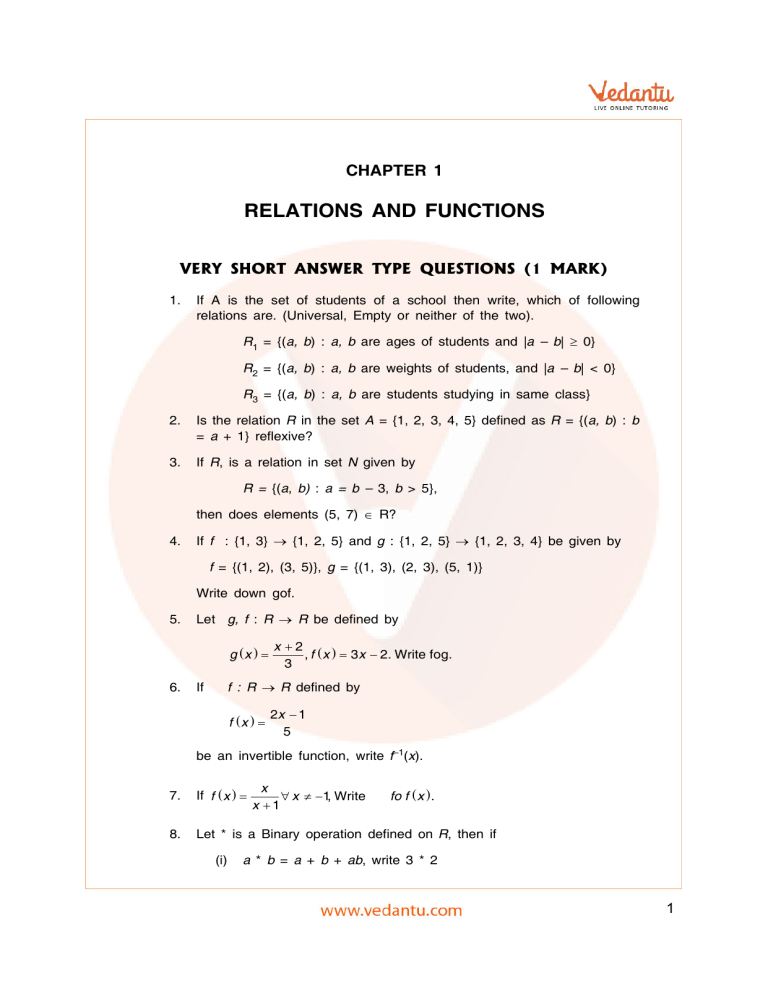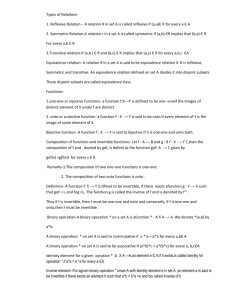
CHAPTER 1
RELATIONS AND FUNCTIONS
VERY SHORT ANSWER TYPE QUESTIONS (1 MARK)
1.
If A is the set of students of a school then write, which of following
relations are. (Universal, Empty or neither of the two).
R1 = {(a, b) : a, b are ages of students and |a – b| 0}
R2 = {(a, b) : a, b are weights of students, and |a – b| < 0}
R3 = {(a, b) : a, b are students studying in same class}
2.
Is the relation R in the set A = {1, 2, 3, 4, 5} defined as R = {(a, b) : b
= a + 1} reflexive?
3.
If R, is a relation in set N given by
R = {(a, b) : a = b – 3, b > 5},
then does elements (5, 7) R?
4.
If f : {1, 3} {1, 2, 5} and g : {1, 2, 5} {1, 2, 3, 4} be given by
f = {(1, 2), (3, 5)}, g = {(1, 3), (2, 3), (5, 1)}
Write down gof.
5.
Let g, f : R R be defined by
g x
6.
If
x 2
, f x 3x 2. Write fog.
3
f : R R defined by
f x
2x 1
5
be an invertible function, write f–1(x).
x
x 1, Write
x 1
7.
If f x
8.
Let * is a Binary operation defined on R, then if
(i)
fo f x .
a * b = a + b + ab, write 3 * 2
1
(ii)
9.
a *b
a b 2
3
, Write 2 * 3 * 4.
If n(A) = n(B) = 3, Then how many bijective functions from A to B can be
formed?
10.
If f (x) = x + 1, g(x) = x – 1, Then (gof) (3) = ?
11.
Is f : N N given by f(x) = x2 is one-one? Give reason.
12.
If f : R A, given by
f(x) = x2 – 2x + 2 is onto function, find set A.
13.
If f : A B is bijective function such that n (A) = 10, then n (B) = ?
14.
If n(A) = 5, then write the number of one-one functions from A to A.
15.
R = {(a, b) : a, b N, a b and a divides b}. Is R reflexive? Give reason?
16.
Is f : R R, given by f(x) = |x – 1| is one-one? Give reason?
17.
f : R B given by f(x) = sin x is onto function, then write set B.
18.
1 x
2x
, show that f
2f x .
If f x log
1 x
1 x 2
19.
If ‘*’ is a binary operation on set Q of rational numbers given by a * b
then write the identity element in Q.
20.
ab
5
If * is Binary operation on N defined by a * b = a + ab a, b N. Write
the identity element in N if it exists.
SHORT ANSWER TYPE QUESTIONS (4 Marks)
21.
Check the following functions for one-one and onto.
2x 3
7
(a)
f : R R , f (x )
(b)
f : R R, f(x) = |x + 1|
(c)
f : R – {2} R, f x
3x 1
x 2
2
(d)
f : R [–1, 1], f(x) = sin2x
22.
Consider the binary operation * on the set {1, 2, 3, 4, 5} defined by
a* b = H.C.F. of a and b. Write the operation table for the operation *.
23.
Let f : R
4
4
R
3
3
be a function given by f x
1
that f is invertible with f x
4x
. Show
3x 4
4x
.
4 3x
24.
Let R be the relation on set A = {x : x Z, 0 x 10} given by
R = {(a, b) : (a – b) is multiple of 4}, is an equivalence relation. Also, write
all elements related to 4.
25.
Show that function f : A B defined as f x
3x 4
where
5x 7
7
3
A R , B R is invertible and hence find f –1.
5
5
26.
27.
Let * be a binary operation on Q. Such that a * b = a + b – ab.
(i)
Prove that * is commutative and associative.
(ii)
Find identify element of * in Q (if it exists).
If * is a binary operation defined on R – {0} defined by a * b
check * for commutativity and associativity.
28.
2a
b2
, then
If A = N × N and binary operation * is defined on A as
(a, b) * (c, d) = (ac, bd).
(i)
Check * for commutativity and associativity.
(ii)
Find the identity element for * in A (If it exists).
29.
Show that the relation R defined by (a, b) R(c, d) a + d = b + c on
the set N × N is an equivalence relation.
30.
Let * be a binary operation on set Q defined by a * b ab , show that
4
(i)
4 is the identity element of * on Q.
3
(ii)
Every non zero element of Q is invertible with
a 1
16
,
a
a Q 0 .
1
is bijective where R+ is the
2x
set of all non-zero positive real numbers.
31.
Show that f : R+ R+ defined by f x
32.
Consider f : R+ [–5, ) given by f(x) = 9x2 + 6x – 5 show that f is
1
invertible with f
x 6 1
.
3
33.
If ‘*’ is a binary operation on R defined by a * b = a + b + ab. Prove that
* is commutative and associative. Find the identify element. Also show
that every element of R is invertible except –1.
34.
If f, g : R R defined by f(x) = x2 – x and g(x) = x + 1 find (fog) (x) and
(gof) (x). Are they equal?
35.
f : [1, ) [2, ) is given by f x x
36.
f : R R, g : R R given by f(x) = [x], g(x) = |x| then find
fog
1
, find f 1 x .
x
2
2
and gof .
3
3
ANSWERS
1.
R1 : is universal relation.
R2 : is empty relation.
R3 : is neither universal nor empty.
2.
No, R is not reflexive.
3.
(5, 7) R
4.
gof = {(1, 3), (3, 1)}
5.
(fog)(x) = x x R
4
5x 1
2
6.
f 1 x
7.
fof x
8.
x
1
,x
2x 1
2
(i)
3 * 2 = 11
(ii)
1369
27
9.
6
10.
3
11.
Yes, f is one-one x 1, x 2 N x 12 x 22 .
12.
A = [1, ) because Rf = [1, )
13.
n(B) = 10
14.
120.
15.
No, R is not reflexive a, a R a N
16.
f is not one-one functions
f(3) = f (–1) = 2
3 – 1 i.e. distinct element has same images.
17.
B = [–1, 1]
19.
e = 5
20.
Identity element does not exist.
21.
(a)
Bijective
(b)
Neither one-one nor onto.
(c)
One-one, but not onto.
(d)
Neither one-one nor onto.
5
22.
*
1
2
3
4
5
1
1
1
1
1
1
2
1
2
1
2
1
3
1
1
3
1
1
4
1
2
1
4
1
5
1
1
1
1
5
24.
Elements related to 4 are 0, 4, 8.
25.
f 1 x
26.
0 is the identity element.
27.
Neither commutative nor associative.
28.
7x 4
5x 3
(i)
Commutative and associative.
(ii)
(1, 1) is identity in N × N
33.
0 is the identity element.
34.
(fog) (x) = x2 + x
(gof) (x) = x2 – x + 1
Clearly, they are unequal.
x x2 4
2
35.
f 1 x
36.
fog
2
0
3
gof
2
1
3
6





